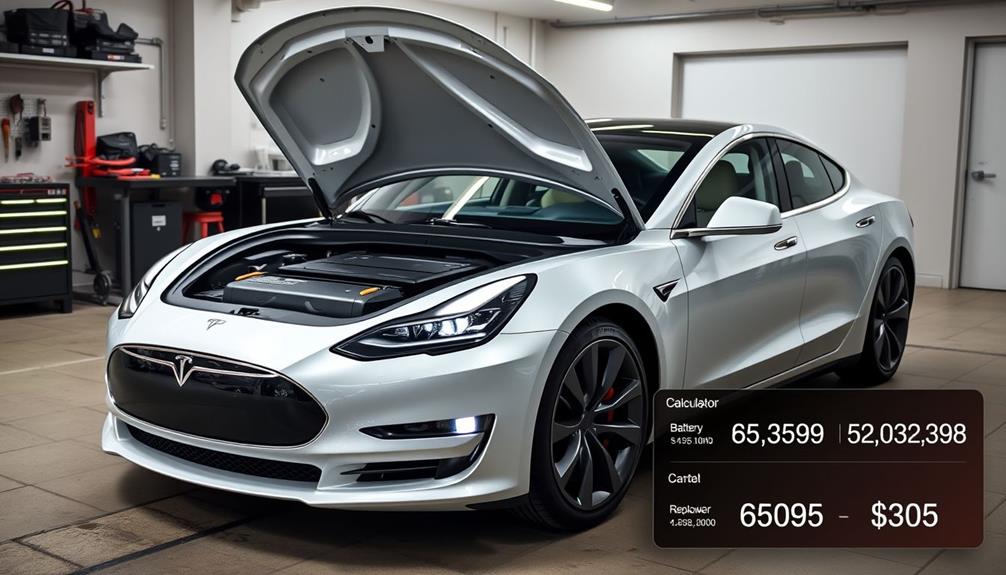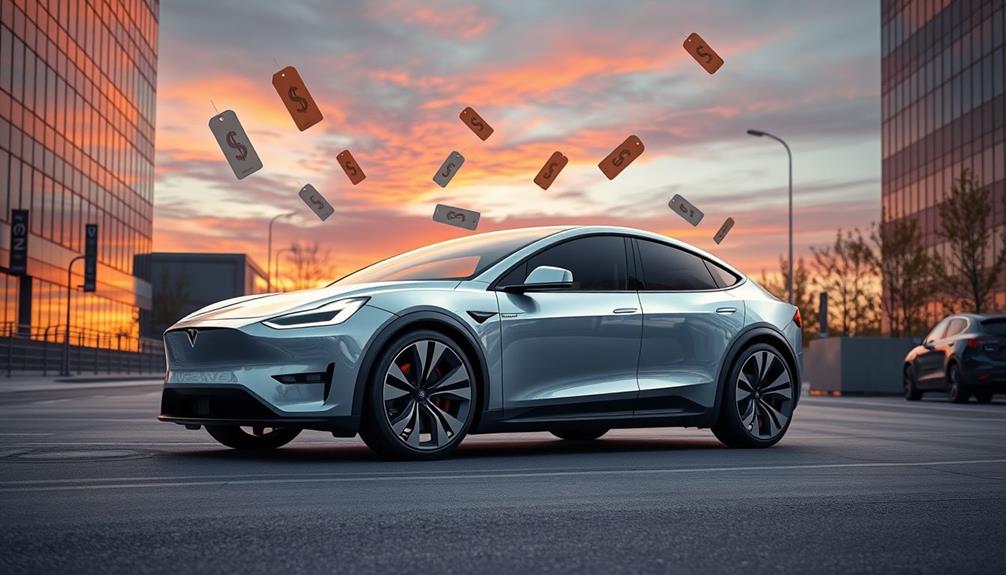Tesla was founded on July 1, 2003, in San Carlos, California. Originally named Tesla Motors, it was inspired by the inventor Nikola Tesla. Visionaries Martin Eberhard and Marc Tarpenning started the company to revolutionize the automotive industry. Elon Musk joined the team in 2004, investing heavily and becoming a key figure in Tesla's success. The company introduced its first vehicle, the Roadster, in 2008, showcasing the potential of electric vehicles. Since then, Tesla has drastically changed the automotive landscape. Stick around to uncover more about Tesla's impressive journey and the innovations that followed its founding!
Key Takeaways
- Tesla was founded on July 1, 2003, in San Carlos, California.
- The original name of the company was Tesla Motors, inspired by Nikola Tesla.
- Martin Eberhard and Marc Tarpenning were the visionaries behind Tesla's founding.
- Elon Musk joined Tesla in 2004, investing $6.3 million in Series A funding.
- The Tesla Roadster was introduced in 2006, marking the company's entry into the electric vehicle market.
Founding of Tesla

Have you ever wondered how Tesla began its journey? Founded on July 1, 2003, in San Carlos, California, Tesla, originally named Tesla Motors, emerged from the vision of Martin Eberhard and Marc Tarpenning. They aimed to revolutionize the automotive industry by focusing on electric vehicles. This mission was partly inspired by the discontinuation of GM's EV1 program, which highlighted the need for innovative alternatives. Tesla’s founding and early years were marked by significant challenges, including financial struggles and production delays. However, the company persevered and eventually gained widespread attention with the release of the Roadster in 2008. This success laid the groundwork for Tesla’s continued expansion and development of new electric vehicle models.
In 2004, Elon Musk joined Tesla after investing $6.3 million during the Series A funding round, becoming the largest shareholder. His involvement proved essential, as he later took on the role of CEO in 2008, guiding the company through its formative years.
Tesla's initial focus was to demonstrate that electric cars could outperform traditional gasoline vehicles, a bold statement at the time. The introduction of the Roadster in 2006 marked a significant milestone, showcasing the potential of electric vehicles and setting the stage for Tesla's evolution.
Today, this groundbreaking company continues to push the boundaries of technology and sustainability, making its founding story a vital part of the EV revolution.
Key Historical Milestones

Tesla's journey is marked by several key historical milestones that have shaped its identity and impact in the automotive industry. Founded on July 1, 2003, in San Carlos, California, Tesla, Inc. started as Tesla Motors, honoring the inventor Nikola Tesla.
The company made a significant leap into the electric vehicle market with the launch of the Tesla Roadster in 2008, showcasing the potential of electric cars.
In June 2010, Tesla went public with its IPO, raising $226 million and opening at a share price of $17. This move was essential, providing the capital needed to innovate further.
The introduction of the Model S in 2012 marked another pivotal moment, as it won multiple awards and solidified Tesla's position as a leader in electric vehicles.
Fast forward to 2023, and the Model Y became the best-selling vehicle globally, a reflection of Tesla's influence on the automotive landscape.
These milestones highlight how Tesla has continuously pushed the boundaries of what electric vehicles can achieve, reshaping the future of the automotive industry along the way.
Elon Musk's Impact

Elon Musk's influence on Tesla has been nothing short of transformative. Joining the company in 2004 as the largest shareholder after investing $6.3 million, you've witnessed how his vision shaped Tesla's trajectory.
As CEO from 2008 onwards, Musk led the company through challenging financial times and oversaw the launch of groundbreaking models like the Model S and Model 3, which revolutionized the electric vehicle market.
Under Musk's leadership, Tesla evolved from a niche player to the world's most valuable automaker, even reaching a market capitalization of $1 trillion in October 2021. His commitment to vertical integration and innovation in battery technology has set Tesla apart, allowing it to dominate the electric vehicle space.
While Musk's management style and social media presence invite scrutiny, they've undeniably bolstered Tesla's brand recognition and fueled rapid growth in the automotive sector.
You can see how Musk's relentless pursuit of innovation and ambition hasn't only transformed Tesla but also the entire landscape of electric vehicles, pushing boundaries and inspiring countless others in the industry.
Product Development Timeline

Since its inception in 2003, Tesla has consistently pushed the boundaries of electric vehicle innovation through a meticulously planned product development timeline.
The journey began with the revelation of the Roadster in 2006, which entered production in 2008. This groundbreaking vehicle showcased advanced battery technology, achieving an impressive range of 250 miles per charge.
In 2012, Tesla launched the Model S, a premium all-electric sedan that offered over 300 miles of range and earned numerous accolades for its safety and performance.
Following that, in 2015, the Model X debuted, introducing unique gull-wing doors and expanding Tesla's product lineup into the SUV market while maintaining the technology from the Model S.
The announcement of the Model 3 in 2016 marked a pivotal moment aimed at the mass market, which officially launched in late 2018. By June 2021, it became the best-selling plug-in electric car globally.
Financial Growth and Challenges

The financial journey of Tesla reflects both remarkable achievements and significant challenges. When Tesla went public in June 2010, it raised $226 million with an initial share price of $17, marking a significant milestone in the company's history.
However, during its early years, Tesla faced financial difficulties that led to Elon Musk becoming CEO in 2008. To tackle cash flow issues, he made tough decisions, including laying off 25% of the staff.
Despite these hurdles, Tesla's stock price surged by 740% in 2020, propelling its market capitalization beyond the combined values of the nine largest traditional automakers.
In October 2021, Tesla's market capitalization temporarily reached $1 trillion, solidifying its position as the world's most valuable automaker.
Energy Products Expansion

Tesla's energy products expansion marks a significant leap towards a sustainable future. In 2016, the acquisition of SolarCity allowed Tesla Energy to integrate solar energy systems and advanced energy storage solutions, like the Powerwall. This innovation enables homeowners to store solar energy, promoting energy independence and sustainability during peak usage or outages.
With a remarkable deployment of 14.7 gigawatts of energy products in 2023, Tesla consistently showcases its commitment to renewable energy. The company also offers utility solutions through the Megapack, designed for large-scale energy storage, further enhancing its energy infrastructure.
Here's a quick overview of Tesla's energy products:
| Product | Description |
|---|---|
| Powerwall | Home battery storage for solar energy |
| Solar Panels | Renewable energy generation for homes and businesses |
| Megapack | Large-scale energy storage for utilities |
| Tesla Energy | Integrated renewable energy solutions |
| Energy Independence | Empowering users to manage their own energy sources |
Future Directions and Innovations

As Tesla continues to push the boundaries of innovation, it's clear that the company is focused on maintaining its leadership in the electric vehicle market. You can expect Tesla to remain at the forefront with continuous innovations in battery technology and autonomous driving, particularly with the development of its Full Self-Driving (FSD) software suite.
To enhance production efficiency, Tesla is expanding its manufacturing capabilities with new Gigafactories across North America, Europe, and Asia. This move not only strengthens its supply chain but also supports the production of both electric vehicles and energy solutions.
With the imminent launch of the Cybertruck and plans for a second-generation Roadster, Tesla is diversifying its vehicle lineup to appeal to various market segments.
Additionally, the growth of Tesla's Supercharger network guarantees that charging infrastructure keeps pace with vehicle adoption, making electric vehicles more accessible to everyone.
Frequently Asked Questions
When Did Tesla Start Ev?
Tesla started its electric vehicle journey with the introduction of the Roadster in July 2006. You'll find it was the first production car to use lithium-ion battery cells, revolutionizing the EV market.
When Did Tesla Get Popular?
You'd say Tesla got popular around 2012 with the Model S. It wowed everyone with its electric capabilities, then skyrocketed further with the Model 3's success, turning EVs into a must-have for many.
When Did Elon Musk Buy Tesla?
You might think Elon Musk bought Tesla, but he didn't. He invested in 2004 and became chairman. He later took over as CEO in 2008, steering the company to success during tough times.
What Car Does Elon Musk Drive?
Elon Musk drives various Tesla models, including the Model S, Model X, and Model 3. He's often seen showcasing their performance, reflecting his commitment to the brand and its mission of sustainable transportation.
Conclusion
In the fast lane of innovation, Tesla's journey from a fledgling startup to an electric titan sparks the imagination. Founded in the crucible of ambition, it's a story painted with milestones and driven by visionaries like Elon Musk. As you watch the electric revolution unfold, picture a world where clean energy flows like a river, reshaping landscapes and lives. With its eyes on the horizon, Tesla's future glimmers with promise, inviting you to be part of its electrifying tale.










